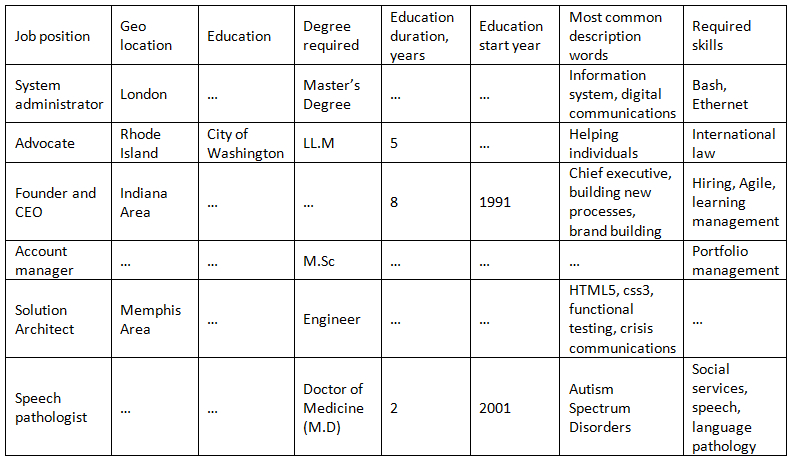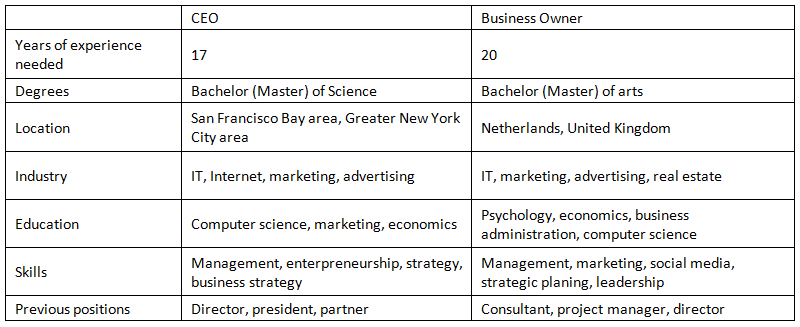Mapping employees’ competence and experience on business needs is a key point of careful strategic planning and aligning business needs and talent capabilities. As people drive the achievement of a company’s objectives, comprehensive talent optimization strategy can give a significant boost to any business. This article shares insights into building a career advisor tool based in part on predictive analytics.
What kind of experience or professional training is needed to drive individual career development? How can a company foster its employees’ professional growth? Building an efficient, robust process for individual career management can be a challenge, especially for large enterprise organizations with an ever-growing number of associates. This is where business intelligence and data-driven analytical methods are needed.
According to the Global Human Capital Trends 2015 report published by Deloitte, people analytics, as a talent management approach, has the potential to change the way human resources are managed. Leveraging data for people decisions can become a big step forward in the process of building a comprehensive talent optimization practice. Resource planning solutions like HCM or ERP allow organizations to store huge arrays of various employee data such as CVs, individual performance results, assessment results, job profiles, etc. This data, combined with the third-party information, can be used to build up a more sophisticated HR strategy for better hiring, employee retention and individual career development.
How ELEKS built a unique career advisor tool
Researching the concept of data-driven career management, we worked out a unique approach leveraging analytical data models. Our goal was to create a model capable of predicting possible career development based on an individual’s previous experience, industry expertise, education, professional skills, etc. Now let’s look at the development process.
Collecting and preparing data. The modeling process required an extensive array of data. To ensure a solid base for analysis, we gathered information from over 11 million publicly available vacancies, resumes, recruiting requirements, job descriptions and much more. We converted all the collected information into the textual format and segmented it into word combinations. As a result, we received a data set with over 145GB of data marked up by part-of-speech tagging.
Classifying, filtering and analyzing. We used the created text corpus for quantitative analysis that enabled differentiating more than 20 unique data categories such as education, job position, projects, references, etc. We further used these categories to classify all the data we gathered. As a result, we received a diverse data set that included information about existing job positions with corresponding professional requirements, as shown in Table 1.
Table 1

Only about 5,000 jobs had a unique description. However, we still considered every combination of attributes for each job to ensure all possible versions are covered and provide the most precise and accurate results. The number of combinations depended on how a specific version of job description was published. Having structured our data this way, we were able to distinguish the most popular jobs and select the skill sets that are most in demand for a specific position, certain industries and regions.
The modeling principle. We chose LinkedIn, the world’s largest professional network, as an information source for predicting career development. Analyzing an employee’s LinkedIn job profile, the solution provides thorough evaluation of individual talent characteristics, including industry experience, skills and competence to define the factors that are more and less important for a particular career model.
With all this information available, it is easy to create a complete picture of a person’s professional expertise and further compare it against similar available job descriptions, focusing on the career path. This way we can discover not only the best matching positions for every level of competence but also the skills and experience that are required for an expert to move up the career ladder.
The purpose of this analysis is to prioritize the efforts spent on an individual career development. An associate will clearly see the skills that are worth focusing on. As a result, less time will be spent on the development of lower-priority skills for a particular role.
A new level of personal career advice. We designed our solution to be as transparent and easy to use as possible. The tool generates a very comprehensive, well-structured and easy-to-read report. The report includes recommendations for possible career promotions and skills required to reach a certain position. For example, if a person is recommended to occupy the position of marketing manager, the suggested skills for improvement will include management, marketing, leadership, marketing strategy, sales, social media marketing, advertising, public speaking, program management, marketing communications, online advertising, digital marketing and other.
The tool also may suggest that the employee consider additional training in the relevant area, for example earning a professional MBA in marketing. Moreover, the report includes possible transitional appointments, future responsibilities and additional years of experience required to reach the target position.
Interesting research findings from the career advisor tool
While testing our tool on live job profiles, we discovered a number of interesting findings. For example, the average industry experience required for CEO appointment is 17 years and the most common skills for this position include management, entrepreneurship, strategy and leadership. When it comes to starting a business, the most common experience is around 20 years in the target industry. Table 2 shows additional relevant information gathered for this position.
Table 2

Note that the most common degree for business owners is Bachelor (Master) of Arts. This means that to start a business, a person may need to focus on developing not only technical but creative skills as well. In general, business leadership, compared to a CEO position, requires three additional years of industry experience.
Our approach also helped us discover the correlation between expert degrees and market demand. As an example, we found that the most common positions for a Microsoft Certified Solutions Expert degree are product manager, project manager, senior web developer and senior business analyst. This expert degree is mostly in demand for IT and services, broadcast media and accounting.
Embracing the business value
Focusing on the value generated by our tool, from an associate’s perspective, the model can show where the person currently is career-wise and what the possible options are for further professional development and growth.
As for an employer’s benefits, our solution can significantly facilitate the process of mapping the existing talent pool with the future growth-driven business needs, identifying the possible talent gaps.
When applying people analytics, a company can gain the following benefits:
- Improve the quality of employees’ education by understanding skills and knowledge that lead to better results for specific professions and positions.
- Improve people decisions by understanding which employee can perform better in a specific role or position.
- Build internal career plans to increase motivation and boost overall productivity.
- Identify factors that lead to personal success and recognize leadership capabilities among employees.
- Understand and improve employee engagement and improve retention rates.
In today’s highly competitive business world, talent optimization can be a game-changer. A tool that enables aligning business needs and talent capabilities will greatly facilitate achieving a company’s objectives and growth strategies.
Daniil Shash is data science product manager at ELEKS, a global organization, providing innovative software solutions with focus on data science, mobility and digital. With over ten years of industry experience, Daniil is presently in charge of the Data Science stream development, including marketing research, product marketing and development, competence development and more. You can contact him at Daniil.Shash@eleks.com.
